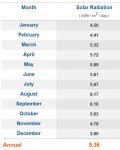G'day our Aussie friend. You are correct about June 21/22 being the longest sun exposure, but as Redbeard's table shows there must be more to the story than date and clouds. One other factor, unless I'm wrong, is that the earth's orbit has the earth closer to the sun in the northern hemisphere winter than in summer. So while the days get "shorter" and the rays less direct, we're closer to the sun, and that makes a huge difference not just in UV radiation but also in outright heat--as demonstrated by our August electric bills--always much higher than June. This June our house consumed 1869 kwh compared with 2186 kwh this August. Last August was worse, when we used 2360 kwh and at a very high price, as U.S. wind powered generators sat still a lot of the time, and demand for electricity nearly tripled the wholesale price here in southeast Texas. Yes radiation and climate are affected by many, many factors...not just SUVs and cattle's intestinal gas in Montana!
I was just introducing effects bit by bit. Start with angle of the sun and daylight hours, then introduce weather patterns.
It really depends on many parameters. Distance to the sun has a major influence when comparing solar radiation on Earth with solar radiation on Pluto. Within the seasons on Earth, it accounts for differences of about 7% between closest distance to the sun (in January) and the furthest (in July). But the influence of the sun-angle and length of day is much bigger, especially when you get further away from the equator. And then you have to consider weather patterns and cloud overage.
In the data for Houston that red-beard posted above, you see the highest amount of solar radiation per day in August. A bit further north, that can shift closer to June, look for example at this data for Ottawa:
Chart and data: Solar Radiation - Monthly data (1 year) for Ottawa (Kanata - Orléans) for Ottawa (Kanata - Orléans), Ontario, Canada
ottawa.weatherstats.ca
Different behaviour due to different latitudes and different weather patterns. That means UV-dependant effects will be very dependant on the actual location.
Then you have to consider temperature effects (that was actually the OP's question). Important for air temperature is the whole system around you. Over summer all the water reservoirs around you will have heated up, oceans, lakes, rivers, etc. Global water currents can change over the seaons. In Australia for example, the East Australian Current (that's the one that Nemo swam in with the turtles) will hit the east coast in summer and bring warm water from the tropics. All of that will result in warmer temperatures in general, and will also help to keep the pool water warmer, it won't cool down as much over night when the air temperatures are higher.
So, temperature dependant effects will usually be highest towards the end of summer, when everything around you has been "soaked" in heat all summer. And this trend is usually less dependant on the exact latitude.


